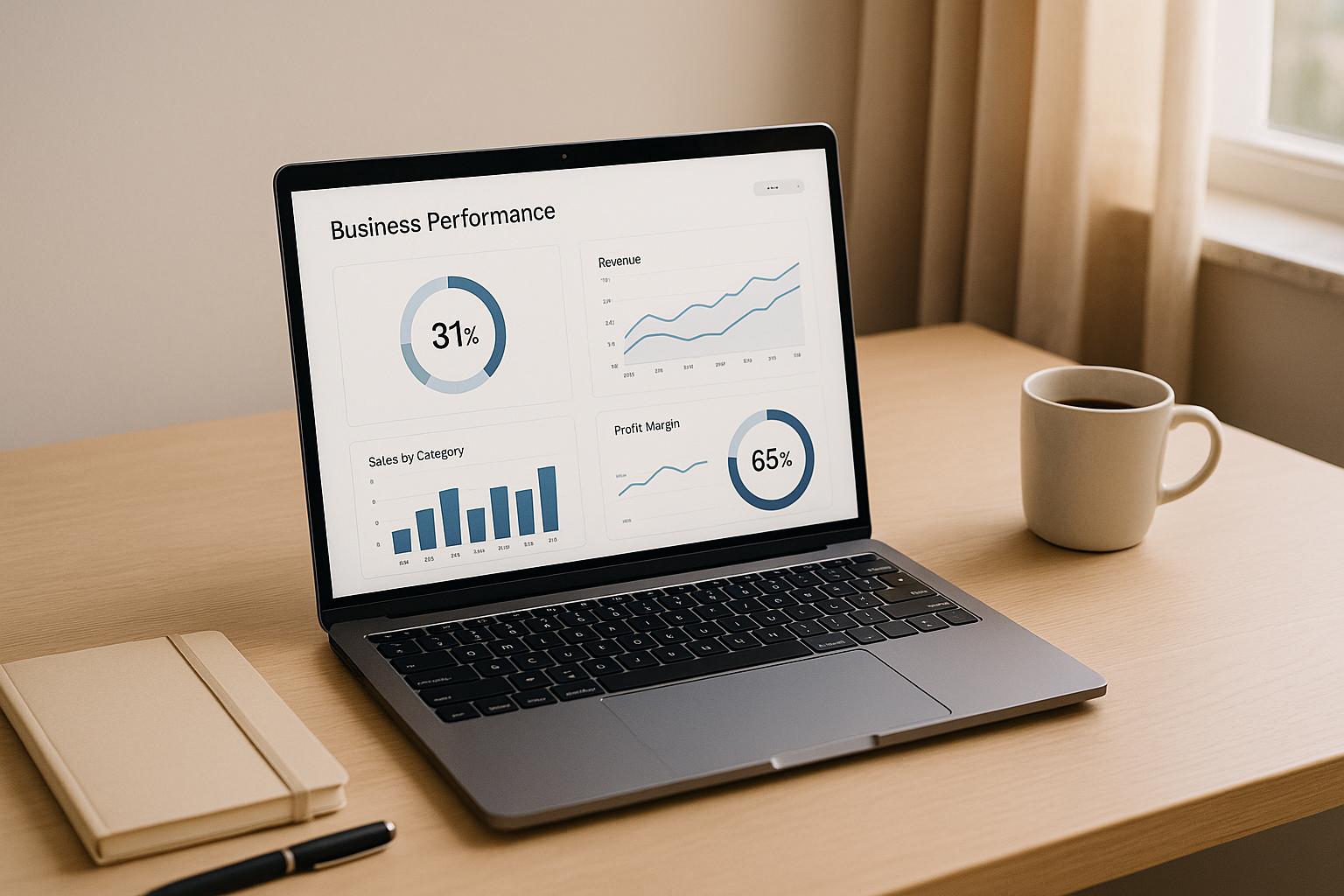How Real-Time Liquidity Tools Improve Cash Flow

Real-time liquidity tools help businesses manage cash flow by providing instant insights, automating processes, and forecasting future finances. These tools connect financial systems like bank accounts, ERPs, and payment platforms to give a complete view of cash positions.
Key Benefits:
- Real-Time Monitoring: Get instant updates on balances and transactions.
- Cash Flow Forecasting: Predict future cash needs and identify trends.
- Automation: Eliminate manual tasks like data entry and reconciliation.
- Risk Reduction: Receive alerts for low balances or unusual activity.
Main Features of Liquidity Tools
Modern liquidity tools streamline cash flow management, offering a clearer view of financial operations and supporting smarter decision-making.
Direct Data Connections
These tools securely connect to your financial systems, giving you a consolidated view of your cash position. By automating data integration, they eliminate manual entry and reduce the chance of errors that could disrupt financial planning.
Key systems that can be connected include:
- ERP systems for comprehensive financial data
- Bank accounts and treasury platforms for cash management
- Accounts receivable and payable systems for transaction tracking
- Payment processing platforms for seamless payment flow
These integrations improve efficiency and ensure more accurate financial operations.
"As our fractional CFO, they accomplished more in six months than our last two full-time CFOs combined. If you're looking for unparalleled financial strategy and integration, hiring PSG is one of the best decisions you can make." - David Darmstandler, Co-CEO, DataPath
Automatic Cash Tracking
Liquidity tools automate the monitoring of cash activity across all connected accounts and systems. This automation offers several benefits:
- Real-time balance updates for all accounts
- Payment tracking for every transaction
- Automated reconciliation for faster and more accurate record-keeping
- Instant alerts for unusual activity or low balances
By automating these processes, businesses save time and maintain better control over their cash flow.
Cash Flow Forecasting
One of the standout features of liquidity tools is their ability to forecast cash flow. By analyzing historical data and current trends, these tools project future cash positions with precision.
Key forecasting features include:
- Identifying seasonal trends and payment cycles
- Scenario modeling to prepare for various business conditions
- Optimizing working capital for better resource allocation
- Early warnings for potential cash shortages
These forecasting tools help businesses set realistic goals and align their strategies with available resources, making liquidity management a core part of financial planning.
Business Advantages
Real-time liquidity tools are changing the way businesses handle cash flow and make financial decisions. By combining strong data integration with accurate forecasting, these tools offer clear benefits for day-to-day operations. They allow businesses to take smarter actions when managing cash flow.
Smarter Financial Decisions
Having up-to-the-minute access to financial data allows businesses to make better financial choices. With a clear view of their cash position, companies can fine-tune their spending, investments, and funding plans.
Real-time insights into cash flow help businesses:
- Spot investment opportunities while keeping enough cash on hand
- Plan large purchases based on actual cash availability
- Negotiate improved payment terms with vendors using accurate forecasts
Reduced Cash Flow Risks
Real-time monitoring helps businesses maintain healthy cash levels and avoid financial trouble. Early detection of issues can prevent small problems from becoming major setbacks.
Some key benefits include:
- Instant alerts for unusual cash activity or low balances
- Early warnings about potential cash shortages
- Improved working capital management through better visibility
- Lower risk of late payments or defaults
"If you want to sleep better at night, hire Phoenix Strategy Group." - Patrick Wallain, Founder / CEO, ABLEMKR
This proactive approach not only reduces risks but also streamlines financial operations, saving both time and money.
Saving Time and Cutting Costs
Automating cash flow processes eliminates manual tasks and improves data accuracy, leading to measurable savings.
| Improvement | Benefit |
|---|---|
| Automated Tracking | Cuts out manual data entry and reconciliation |
| Real-time Reporting | Speeds up financial data analysis |
| Predictive Analytics | Helps avoid costly cash shortages |
These tools make financial management faster, easier, and more reliable.
sbb-itb-e766981
Setting Up Liquidity Tools
Integrating real-time liquidity tools requires careful planning to ensure everything works together seamlessly.
Connecting Your Systems
The process involves three main steps: evaluating your systems, setting up APIs, and thorough testing.
- System Assessment: Review all systems handling cash data, such as accounting software, banking platforms, and payment systems.
- API Integration: Set up secure API connections to streamline the flow of data across platforms.
- Testing Protocol: Run parallel tests to confirm data accuracy and resolve any issues.
Here’s a quick overview of the timeline and major activities:
| Integration Phase | Duration | Key Activities |
|---|---|---|
| Initial Setup | 1–2 weeks | System mapping, API configuration |
| Testing | 2–3 weeks | Data validation, error checking |
| Full Deployment | 1 week | System cutover, monitoring |
Staff Training and Teamwork
Proper training is crucial for success. Equip your team to handle tasks like daily monitoring, interpreting reports, responding to alerts, and coordinating across departments.
"If you want to sleep better at night, hire Phoenix Strategy Group." - Patrick Wallain, Founder / CEO, ABLEMKR
Phoenix Strategy Group highlights the importance of having a unified team of finance and revenue experts to achieve measurable outcomes. Once trained, your team can maintain strong performance through consistent reviews.
Regular Review and Updates
Keep your liquidity tools running smoothly with regular check-ins. Here’s how:
- Weekly: Review forecasts and adjust targets as needed.
- Monthly: Assess system performance and address any issues.
- Quarterly: Update strategies based on the latest data.
- Annually: Conduct a full system evaluation.
These practices allow for quicker decisions and better cash flow management, ensuring your liquidity strategy stays effective.
Conclusion
Modern liquidity tools have transformed the way businesses manage cash flow, offering smarter, more efficient solutions.
Key Advantages
Real-time liquidity tools bring automation, instant insights, and predictive analytics into cash flow management. They provide better control over cash positions, helping businesses make quicker decisions and reduce financial risks.
Some standout benefits include:
- Improved operational efficiency and accuracy
- Reduced need for large cash reserves
- Enhanced financial planning based on data
Why Upgrade to Modern Tools
Traditional finance methods often keep data isolated, creating inefficiencies and increasing risks. Liquidity tools address this by integrating data streams, offering real-time insights, and automating workflows to cut down on errors.
"As our fractional CFO, they accomplished more in six months than our last two full-time CFOs combined. If you're looking for unparalleled financial strategy and integration, hiring PSG is one of the best decisions you can make." - David Darmstandler, Co-CEO, DataPath
Phoenix Strategy Group Services

Phoenix Strategy Group specializes in custom solutions to improve cash flow management. Their services include:
| Service Area | Key Benefits |
|---|---|
| System Setup | Tailored metrics and financial models |
| Strategic Planning | Integrated finance and revenue systems |
| Team Alignment | Coordinated strategies for growth |
| Cash Flow Optimization | Better forecasting and budgeting |




